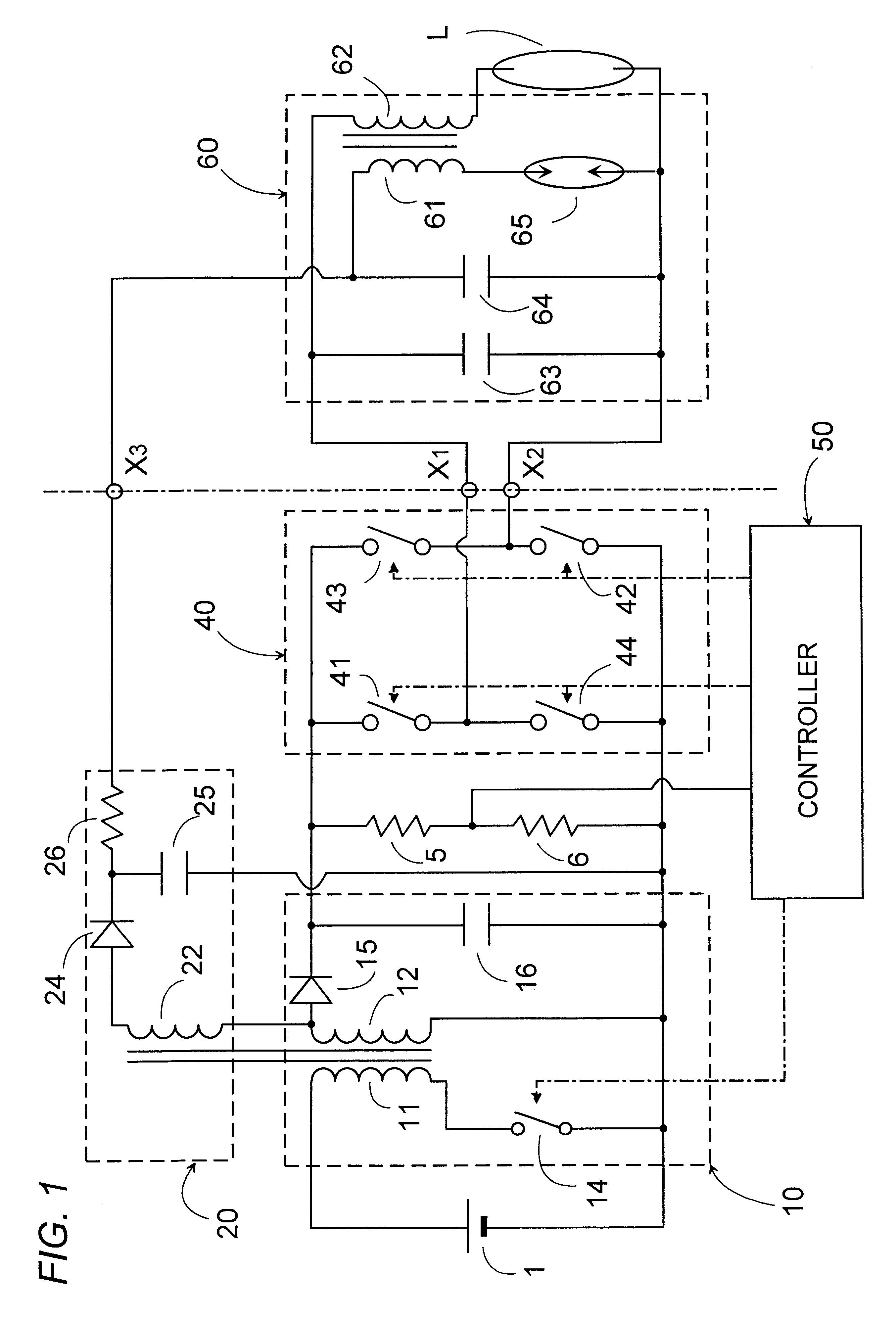Ballast for a discharge lamp
a discharge lamp and ballast technology, applied in the field of ballast for a discharge lamp, can solve the problems of unnecessary high voltage, possible electrical shock hazards for personnel, undue stress on the components of the starter
- Summary
- Abstract
- Description
- Claims
- Application Information
AI Technical Summary
Benefits of technology
Problems solved by technology
Method used
Image
Examples
first embodiment
Referring now to FIG. 1, there is shown a ballast for a discharge lamp in accordance with a first embodiment of the present invention. The ballast is suitable for operating a high intensity discharge lamp for use as a headlamp of an automobile and a light source of LCD projector. The ballast comprises a DC-to-DC converter 10 adapted to be connected to a DC power source 1, such as a car battery or the like fixed voltage source, for providing a DC power, a booster 20 connected to the DC voltage source 1 through the converter 10 to generate a boosted voltage, and an inverter 40 receiving the DC power from the converter 10 and proving an AC power for operating the discharge lamp L. The booster 20 is connected to provide the boosted DC voltage to a starter 60 which responds to generate a starting voltage of sufficiently high level for starting the lamp L. Also included in the ballast is a power controller 50 which is responsible for controlling the converter 10 and the inverter 40 to sta...
second embodiment
FIG. 8 shows a ballast in accordance with a second embodiment of the present invention which is identical to the first embodiment except that a booster 20D is integrated in the inverter 40D. Like parts are designated by like numerals with a suffix letter of "D". The booster 20D includes a series combination of a diode 37, a resistor 31D, and a capacitor 32D connected across transistor 44D, and a transformer with a primary winding 33D and a secondary winding 34D. The primary winding 33D is connected in series with a bi-directional thyristor 35D across capacitor 32D, while the secondary winding 34D is connected in series with a diode 36D across the capacitor 25D. While the transistor 41D is on, capacitor 32D is charged through diode 37 and resistor 31D by the DC voltage from capacitor 16D of the converter 10D. As the capacitor 32D is charged up to a break-over voltage of thyristor 33D, thyristor 33D becomes conductive to initiate an oscillation in a closed circuit of capacitor 32D, th...
third embodiment
FIG. 10 shows a ballast in accordance with a third embodiment which is identical to the second embodiment except that a booster 20F is connected differently with the inverter 40F. Like parts are designated by like numerals with a suffix letter of "F". The booster 20F comprises a series combination of a diode 37F, a resistor 31F, and a capacitor 32F connected across a transistors 43F, and a transformer with a primary winding 33F and a secondary winding 34F. The primary winding 33F is connected in series with a bi-directional thyristor 35F across capacitor 32F, while the secondary winding 34F is connected in series with a diode 36F across the capacitor 25F. While the transistor 42F are on, capacitor 32F is charged through diode 37F and resistor 31F by the DC voltage from capacitor 16F of the converter 10F. As capacitor 32F is charged up to a break-over voltage of thyristor 33F, thyristor 33F becomes conductive to initiate an oscillation in a closed circuit of capacitor 32F, thyristor ...
PUM
 Login to View More
Login to View More Abstract
Description
Claims
Application Information
 Login to View More
Login to View More - R&D
- Intellectual Property
- Life Sciences
- Materials
- Tech Scout
- Unparalleled Data Quality
- Higher Quality Content
- 60% Fewer Hallucinations
Browse by: Latest US Patents, China's latest patents, Technical Efficacy Thesaurus, Application Domain, Technology Topic, Popular Technical Reports.
© 2025 PatSnap. All rights reserved.Legal|Privacy policy|Modern Slavery Act Transparency Statement|Sitemap|About US| Contact US: help@patsnap.com



